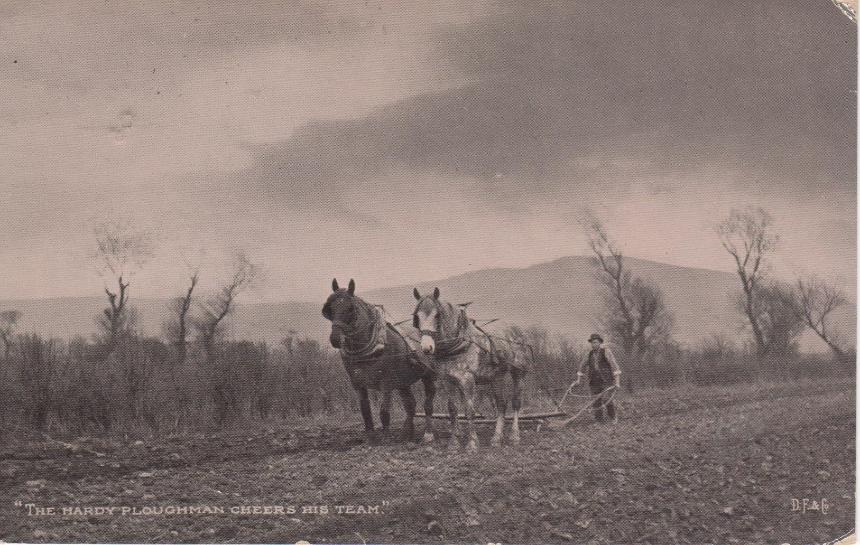
From my own collection
Chuleigh Farm
1798
A plan of Chuleigh Farm, Ashburton, with particulars, by Alexander Law,
is held at Exeter Cathedral library and archives. Item ref M9
In 1830 Thomas Symons of Halsworthy, Staverton, published an apology to Thomas Hext, a yeoman of Ashburton. He had 'maliciously, unjustly and without foundation' said that Mr Hext had detained a steer bullock belonging to him; he now wished to show his 'sorrow and contrition', and thanked Thomas Hext for agreeing to cease legal proceedings.
This is presumably the Thomas Hext below, who may or may not have been at Chuleigh at the time.
Exeter and Plymouth Gazette 6 June 1830, p1 col5
In April 1833 Thomas Hext, a bachelor, married widow Charlotte Hern by licence.
Charlotte had previously married to William Hern, a widower, in 1824
Parish records
T Hext, Chuleigh, was letting 'a convenient house' in Ashburton in 1836. It had two parlours and two kitchens, five bedrooms, use of a wash-house and an attic. A coach-house, stable and garden 'well-supplied' with fruit trees was available if required.
Exeter and Plymouth Gazette 5 March 1836, p1 col2
Mrs C Hext, was offering board and lodgings at Chuley in March 1841. The advertisement stated that the house was newly erected.
Western Times 20 March 1841, p6 col2
In the 1841 census Thomas Hext, aged about 50, is a farmer at Chuleigh. Charlotte Hext aged about 40, and Charlotte Hext aged 4 are in the same household
1841 census HO107, piece no. 253, folio 9, p13
1843 Mrs C Hext was letting a sitting room plus one or two bedrooms at Chuleigh Farm. 'Terms moderate'.
Western Times 13 May 1843, p2 col3
Similar advertisements continue until 1852
In the 1851 census 53 year old Charlotte Hern, farmer's wife, is head of Chuley House. John Hern, 23, a farmer of 50 acres employing 7 men, is her son, and 13 year old Charlotte Mary is her daughter.
1851 census HO107, piece no. 1871, folio 358, p1
Thomas Hext, a farmer aged 59, is with his brother Richard at Lower Hele in 1851. Both brothers were born in Ashburton.
1851 census HO107, piece no. 1871, folio 363, p11
A Thomas Hext aged 60 was buried at Ashburton in January 1852
Parish records
Mr John Hern, of Chuley Farm, was letting a tanyard in 1854.
Western Times 20 May 1854, p4 col2
For more on the Hern family see under Individual Families
*******
1808 'Some years ago a cow of the Somersetshire breed, belonging to Mr Tozier, in the parish of Ashburton, produced soon after calving 3lb 1 ounce of butter daily...the cow was fed upon grass, with about a quarter of a peck of barley, mixed with a peck of grains, morning and evening.'
General View of the Agriculture of Devon, Charles Vancouver, London, 1808, p335Parish records
Horsey Hill and Tozer's Ground were for sale in June 1814. A good farmhouse was set in 140 acres of mixed pasture, meadow and arable ground, plus 20 acres of coppice. A fenced off area contained 'young and thriving timber'. The River Dart was on a western boundary, and the whole was a short distance from Holne Chace and Spitchwick.
Mr Penny at Horsey Hill could be contacted for viewing.
Exeter Flying Post 30 June 1814, p2 col3
Exeter Flying Post 22 June 1815 p1 col3
* A building in which anything was crushed, but particularly apples
https://en.oxforddictionaries.com/definition/pound_house
** A building for depositing the ash from fires, (1) for safety, and (2) to store it until it was used on the land.
See http://www.legendarydartmoor.co.uk/ash_house.htm
1831 Daniel West of Ashburton, farmer, was discharged from the Insolvent Debtors' Court.
North Devon Journal 31 March 1831 p3 col3
Western Times 27 January 1838, p3 col1
Interested persons were to contact Mr Solomon Tozer or Mr Stephen Upton Yolland.
Western Times 16 March 1839 p2 col3
*******
According to Stephen Woods, Samuel Hannaford (Roger's brother) had inherited Mead on the death of his father in 1833.
Exeter and Plymouth Gazette 19 March 1842, p1 col1
Dartmoor Farm, Stephen Woods, Halsgrove, 2003, p173
Lower Mead was for sale by June, with the premises consisting of a farmhouse, outbuildings and 56 acres. A lime kiln and lime rock, on the road from Ashburton to Mead, was also for sale. According to the advertisement Mr Stephen Yolland had occupied the farm for many years.
Western Times 18 June 1842, p2 col3
A year later the wife of Roger Hannaford, yeoman, gave birth to a son at Higher Mead.
Western Times 15 July 1843, p3 col1
In the following year, 1844, a large sale of animals and equipment was about to be held at Higher Mead Farm. Sheep, bullocks, horses and pigs were for sale, together with hay and straw. Also for sale were carts, a winnowing machine, harness, a stone roller and various other items.
Stephen Woods says that Roger Hannaford emigrated to America - the sale was without reserve, and this may have been the reason.
Exeter and Plymouth Gazette 24 August 1844, p1 col2
Op cit p172
The Western Times reported in 1852 that Mary Hannaford had recently died in Cincinnati, Ohio, America. She was the wife of Roger Hannaford, late of Higher Mead Farm, Ashburton. She was 42.
Western Times 16 October 1852, p5 col3
For more on the Hannafords in the USA, see Beyond Ashburton
*******
Western Times 23 January 1841 p2 col2
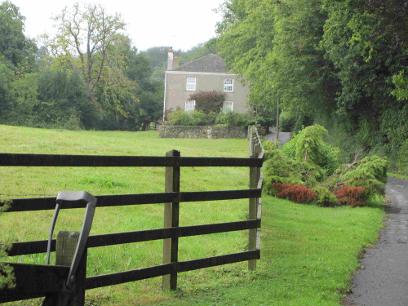
My own photograph 2015
Western Times 23 September 1843 p3 col4
Elizabeth, wife of Mr J S Bovey, died at Horseyhill Farm in April 1842. Aged 34, she had 5 young children.
Western Times 10 July 1847 p6 col3
Western Times 8 April 1848 p5 col3
Western Times 1 February 1851, p1 col1
*******
The hay harvest in 1856 was set to be the finest ever known, in both quality and quantity. The corn fields were 'luxuriant', and the potatoes 'promising'. The apple crop was the only exception to a highly promising outcome.
Western Times 12 July 1856 p7 col3
*******
Farmers in the 1861 census
John Bickford - Barton
John Bickford - Wrigwell
John W. F. Bickford - Coombe
Benj G. Butler - Chipley
Roger Chaffe - Higherbarn Farm
Richard Cooker - No address given, but Lemonford Mill the next property on the schedule.
William Cooker - Son of Richard, above
Thomas Easterbrook - No address, but 1 Violet Cottages next on schedule.
Samuel Easterbrook - Belford Mill. Brother-in-law to head of house, and may not be permanent resident.
George Gidley - Higher Headborough
William Gill - Pitt Farm
John Harris - Burn
John Hern - Chuley
Richard Hext - Yolland Hill Farm
Thomas Hext - Pubsham
William Hooper - Dolbear Farm
Bartholomew Irish - Westbrook Farm
Henry Jonas - Horsehill
William Kentshole - No address given, but properties either side on schedule in Heavyhead Lane. Lodger.
Richard Kingswill - Welstor Farm
Thomas A. Lambshead - Alston. Brother-in-law to head of house, and may not be permanent resident.
John Langler - Rew Farm
John Langler - Rew Farm, son of John above.
George Leaman -Ivy House
John Maddick - Under Auswell
Joseph Mann - Summerhill
Thomas Mann - Gale Farm
William Mann - Goodstone East Farm
Henry Maunder - Lower Whiddon
Thomas Maunder - Wood Place Farm
James Norrish - Stone Farm
Robert Northcott - East Street
William Northcott - East Street. 'Farmer's son.' Son of Robert above.
John Nosworthy - Higher Farliacombe
Richard Palk - Alston
Richard Pethybridge - Bura
William Rowlands - Auswell
William Henry Savidge - Fursleigh
Henry H. Scagell - West Street
Edward Skinner - 1 Lemonford Farm
Joseph Skinner - Caton Farm
Joseph Skinner - North Street
Elias Smerdon - Queen of Dart
Elijah Smerdon - Higher Mead Farm
Elisha Smerdon - No address, but census taken between Riddicleave and Elliotshill
James Smerdon - Elliotshill
John Smerdon - Lower Mead Farm
Richard Smerdon - Lower Lodge
Thomas Smerdon - Lower Brownhill
Thomas Smerdon - Higher Whiddon
Thomas Smerdon - Tower Bowdly
Thomas P Smerdon - North Street
William Smerdon - No address given, but follows on from Rew Farm on the schedule
William Smerdon - Higher Bowdley
Thomas Tripe - Higher Henbeer
William Tuckett - Higher Rushlade
William Widger - Goodstone West Farm
Charles Wills - Lurcombe
Richard Wills - 3 Lemonford Farm
James Woodley - Halsehanger
John Yolland - Pitley Farm
http://www.freecen.org.uk
******
'Devonshire. The change of tenancy takes place either at Lady-day or at Michaelmas. In some instances it is at Christmas, but these are rare. There are very few agricultural customs in this county. Nearly all the farms are held under lease or agreement, and any question that may arise is regulated thereby. If there is no lease or agreement the outgoing tenant may in most instances sell everything off. When there are tenancies at will, from year to year, they are determinable by a notice, which may be given by either party six months previous to the termination of any year of the tenancy. An auction is usually held, and everything is sold off, including the manure. A tenant who goes out at Lady-day does not sow the wheatcrop, except by agreement. The landlord repairs the walls and slated roofs, in some instances also the doors and floors; the tenant has to do all other repairs.
We are indebted to Mr W Rolstone Whiteway of Orley House, Ashburton, for an account and revision of the customs of this county.'
Journal of the Royal Agricultural Society of England, vol 4, London 1868, p151
*******
Later the same year George Rowland, son of George Rowland of Headborough Farm, was seriously injured when his loaded gun came apart, exploded, and shattered his right foot. Dr. Gervis was in attendance.
Exeter and Plymouth Gazette, 25 March 1869 p7 col3
Exeter and Plymouth Gazette, 24 September 1869 p7 col7
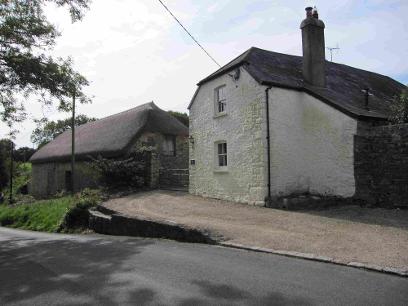
My own photograph 2015
Western Times 21 March 1876 p8 col5
In 1877 William Kingwill of Westabrook Farm committed suicide by hanging. He was discovered by W. Irish, a neighbouring farmer. At the inquest his wife testified that he had been depressed for some time, and drank a lot of cider, which she believed had an effect on him. The jury returned a verdict of temporary insanity.
Western Times 2 June 1877 p4 col2
Western Times 30 January 1894 p3 col2
By 1897 a Practical School of Agriculture was attached to the Grammar School in Ashburton. J. Smerdon of Lower Mead Farm was the instructor.
1899 Samuel D. Mann, a farmer of Brownshill Farm, sued Alfred Kingwell, late of the Culloden Inn, and George Thorning, 'small farmer' for the cost of a field of barley that he had sold to them. Judgment was given against Kingwell, but it was decided that Thorning had no case to answer.
Western Times 6 May 1899 p3 col4
Exeter and Plymouth Gazette 18 April 1902 p14 col5
1906 An inquest was resumed into the death of Uriah Cottle of Blackmoor, who had died from a gunshot wound. It appeared to be suicide, but the jury returned an open verdict, accepting the cause of death but unable to say how it had been inflicted.
The inquest had had to be adjourned because two sons of the deceased had been intoxicated, and at the Ashburton Police Court both pleaded guilty to being drunk and disorderly. Having been 'severely reprimanded' and fined, they were later certified as wandering lunatics, and taken to the Devon County Asylum.
Exeter and Plymouth Gazette 22 June 1906 p3 col5
1906 Summerhill Farm, a farmhouse and 93 acres was sold together with the borough lordship and manor of Ashburton for £550, with the Hon R Dawson was the purchaser. It was one of thirteen lots of houses, farm buildings and land which had been the property of Sir R B W Jardine.
Exeter and Plymouth Gazette 22 September 1906 p3 col7
1907 Mr S Winsor, the tenant of Higher Barn Farm, bought it for £1560.
Western Times 5 July 1907 p12 col1
Exeter and Plymouth Gazette 21 June 1828 p1 col1
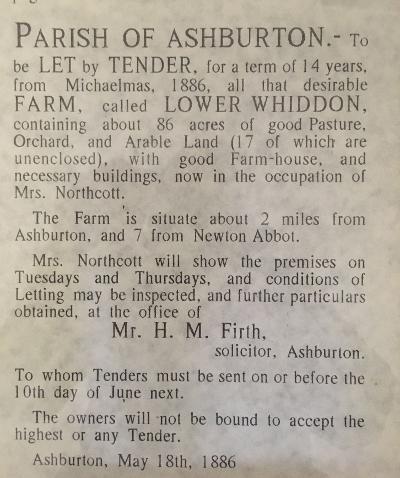
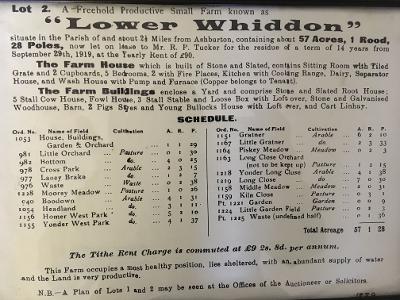
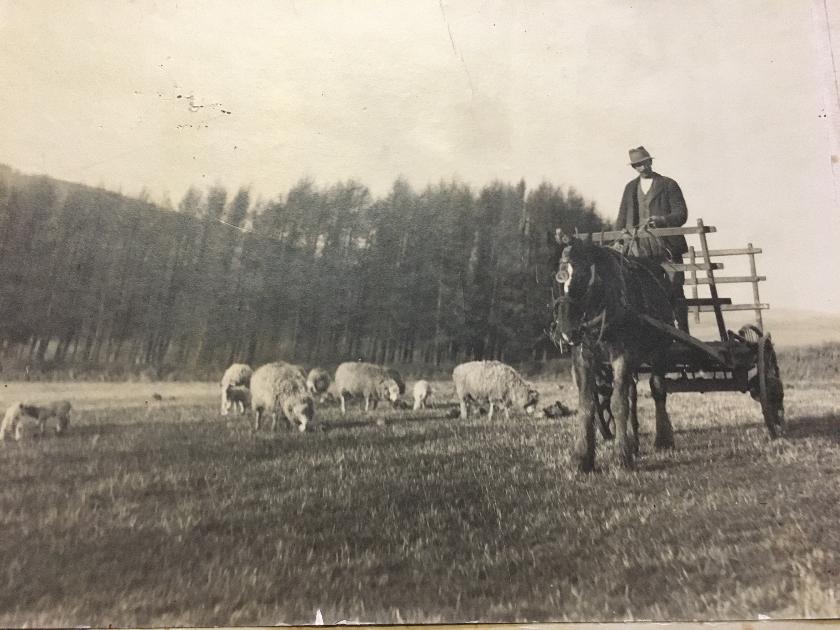
Western Times 23 September 1921 p2 col4
In 1924 Caton Farm sold to Mr J Cock for £2050
Coombe Farm sold to Mr F Thorn, the tenant for £875
Western Times 28 November 1924 p8 col2
1926 William Henry Shilston, of Baddaford, pleaded not guilty to driving a motor vehicle to the public danger. He admitted that he was driving a motor milk van at 12 to 14 miles per hour when he emerged from a side road and was hit by another vehicle going at 15 miles per hour. The other driver had sounded his horn 'from the 'danger posts' to the corner at Shinner's Bridge, Dartington.
Western Times 18 June 1926 p11 col5
In 1931 Westabrook Farm sold to Mr Tapper for £3000.
Western Times 2 April 1931 p7 col3
Western Morning News 18 December 1940, p5 col5
1944 (during World War 2) Frederick James Marshall of Lower Meade was fined £5 for refusing to provide accommodation for two children at his farm. He said that three men including himself farmed 153 acres, whilst his wife coped with the poultry, pigs and dairy.
Western Morning News 26 August 1944 p6 col3
*******
Jonathan Cock Jnr, Lower Waye
Samuel Cox, Alston
Samuel Edgecombe Jnr., Higher Mead
William Edgecombe, Higher Mead
James Thomas Ford, Lergecombe
James French, Caton
William Gill, Pitt
Francis Gooding, Goodstone
Thomas Hamlyn, Pitley
Edwin Hannaford, Higher Whiddon
Richard Hext, Yolland Hill
Samuel Dudor Mann Jnr., Lower Brownswell
Charles Rowland, Lower Headborough
John Stanbury, Rushlade
Elijah Smerdon, Summerhill
John Smerdon, Gages
John Tancock, Balland
George Thorning, North Street
John Tuckett, Lower Bowdley
John Wakeham, Lower Mead
William Whiteway, Westabrook
William Wrayford, Priestaford
William Henry Yolland, Dolbear
Charles George Wills Yolland, East Street
See People and Properties 1900
*******
Ruslade, near Ashburton, was to be sold in May 1813. A farmhouse, barn, linhay, stables and outhouses were included in the sale; the whole set in approximately 70 acres of mixed arable ground, pasture and meadows. The current occupier was Mr John Irish.
Exeter Flying Post 27 May 1813, p2 col3
37 year old William Tuckett is at Higher Rushlade in the 1861 census.
Widower William Bridgeman, an agricultural labourer, is at Lower Rushlade with his daughter and two sons, of whom 14 year old Jonothon is a farm servant.
http://www.freecen.org.uk
Higher Rushlade was to have been auctioned on the 30th June 1868, but the property was sold beforehand by private contract.
Western Times 19 June 1868 p1 col3
At the time of the 1871 census George Rowe, his wife and daughter were living at Higher Rushlade. He was an agricultural labourer.
Henry Irish was at Lower Rushlade, a farmer of 138 acres employing two labourers and three boys. As well as his wife Sophia* and two children, four servants are listed on the census. The youngest, John Layman, is 11.
1871 census RG10, piece no. 2080, folio 18, p14
*Henry Irish of Bagtor Barton, Ilsington, had married Sophia Brock of Holloway, Kenn in May 1867
Exeter and Plymouth Gazette 7 June 1867 p5 col6
In December 1881 Henry Irish of Rushlade was summoned for allowing his cattle to stray.
In 1883 Henry Irish, farmer, was fined £1 for working a horse in an unfit state.
Exeter and Plymouth Gazette 24 April 1872 p3 col4
Western Times 20 December 1881 p6 col2
Western Times 20 October 1883 p4 col1
53 year old Henry Irish of Rushlade was buried on July 9th 1886.
Parish records
John Stanbury, born in Chagford, is farming Rushlade in 1901.
A clearance sale was held at Rushlade in March 1905 for Mr J Stanbury.
1901 census RG13, piece no.2053, folio 19, p4
Totnes Weekly Times 4 March 1905 p4 col2
1908 William Henry Irish, eldest son of the late Henry Irish, formerly of Rushlade, married Miss Florence Paul at All Saints' Church, Kenton.
Western Times 8 May 1908 p5 col6
In the 1911 census 57 year old Robert Codd, who was born at South Brent, is a farmer at Rushlade. With him are two grown-up children: Elizabeth, 32, who is a dairy worker ('working on farm' crossed out) and James, 25, who is also working on the farm.
1911 census RG14, piece no 12726
When John Codd, butcher and cattle dealer of South Brent, died in 1916, his cousin R Codd of Rushlade was one of the bearers.
Western Times 28 January 1916 p14 col2
Robert Cuming Codd died in September 1925 and left estate of £4214 7s 5d gross, £4178 9s 5d net. Probate was granted to his sons James Francis Codd of Rushlade and Victor Cuming Codd of Stoodley, Holne, and to his brother Frederick William Smerdon Codd of Broomborough, Totnes. All were farmers.
Western Times 12 November 1926 p10 col2
James F Codd married Sarah A Hamlyn in the December quarter of 1936, in the Newton Abbot registration district.
https://www.freebmd.org.uk
In the 1939 Register James F Codd, born 1886, is a farmer at Rushlade. With him is his wife Sarah H Codd born in 1908 plus two people on whom the records are still officially closed.
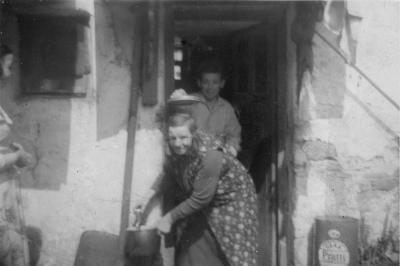
1939 Register
* This is presumably Elizabeth Smerdon Codd, the daughter of Robert. Her birthdate varies in records, but her birth was registered in the March quarter of 1875, in the Plympton registration district.
Left: Miss E Codd in the doorway of the original farmhouse, later demolished .
Many thanks to Robert Green for the above photograph and information.
*John Satterly talks of the fire brigade attending a thatched barn at Rushlade at the end of the 19th century.
Memories of Ashburton in Late Victorian Days, John Satterly, Report and Transactions of the Devonshire Association, vol 84, 1952,Torquay, p24
James and Sarah had four children, including Elizaberth Ann Irene Codd, born in 1938
https://www.freebmd.org.uk
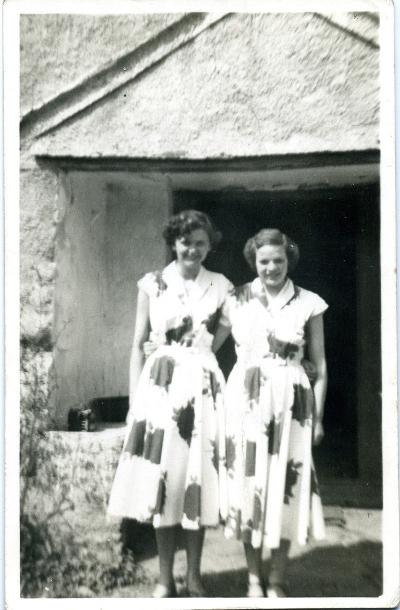
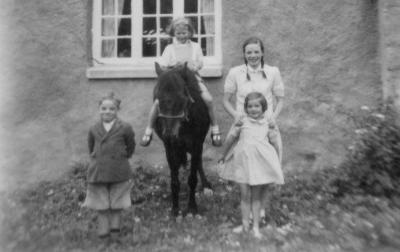
Left: Elizabeth Codd and her sister Kathleen.
Above: Elizabeth's brother Stuart is standing on the left.
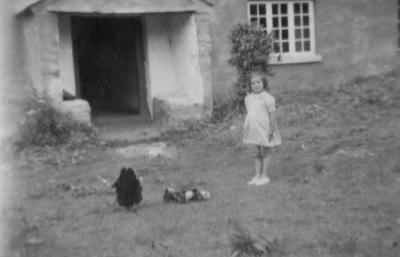
Many thanks to Robert Green for the above photographs and information.
William Thomas Soudon Smerdon of Waverly, Bowdley, died on 28th June 1905, leaving £8730 4s 2d net. Probate was granted to his nephews, William Henry Abbot of Higher Bowdley, Mr. Thomas Smerdon Abbot of Dinnacombe, Cornworthy, Totnes and Mr. John Smerdon of Gages. Bequests included sums to John and Walter Thomas Shapley, nephews of his late wife, and an annuity to his sister Eliza Ann Smerdon.
Western Times 1 November 1905 p2 col3
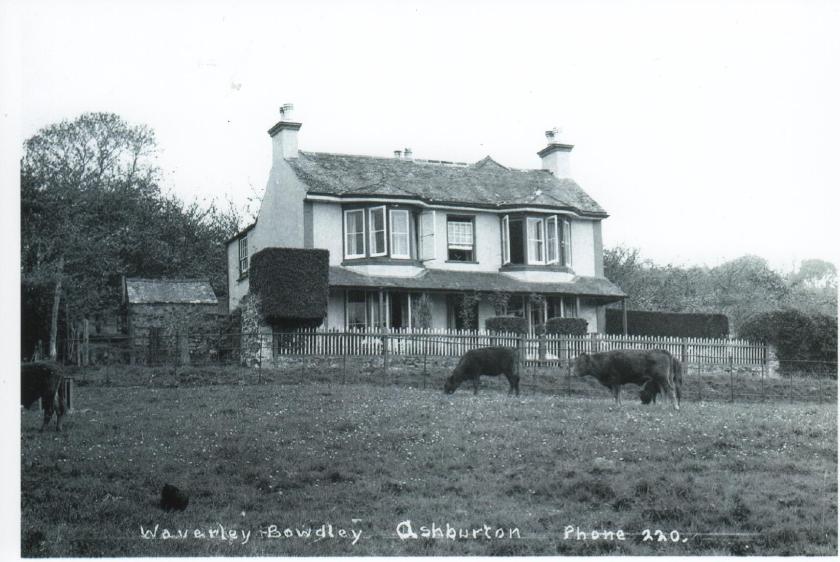
***
Cider
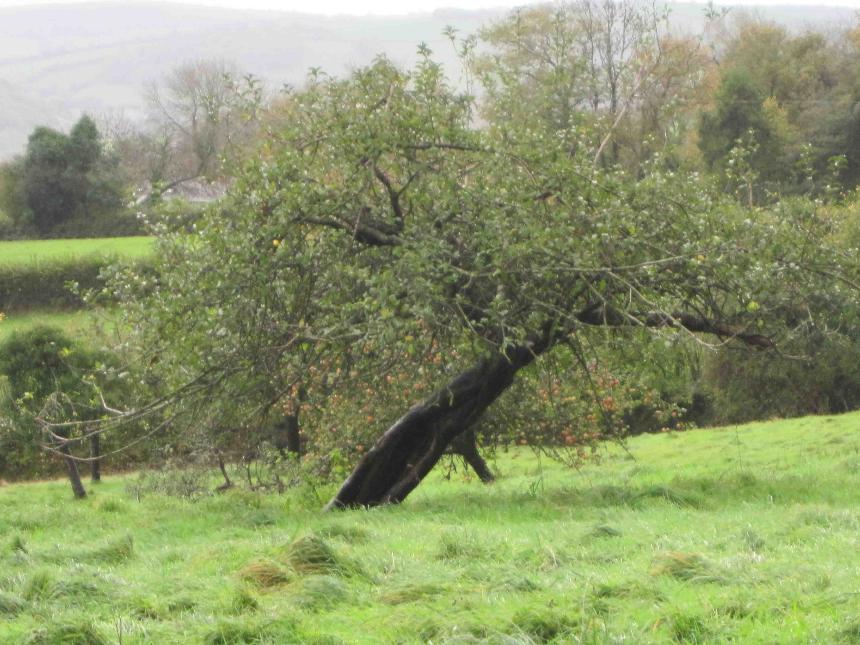
Above: Remains of old apple orchard, Druid area.
My own photograph 2015
'Throughout a great part of this county, particularly the southern districts, cider constitutes a very material article of rural economy. Every farmer has his orchard, which supplies him, in the first place, with an agreeable and wholesome beverage for himself and family, and the surplus he disposes of to the cider merchant. The operations of the farmer in preparing his cider are simple and easy. The juice of the fruit being extracted by means of the pounding mills and the press, the liquor is put into large vats, where it is left to ferment; and when the fermentation is arrived at full perfection, of which they judge by the head beginning to break, the cider is then drawn off into hogsheads or barrels, and kept for family use, or sold to the cider merchant, who racks and prepares it for the London and other markets.'
General view of the county of Devon, with observations on the means of its improvement, Robert Fraser, London, 1794, p67
'The
apple crop varies very much in different parts of this district;
between the River Dart and Torbay they have scarcely a twelfth part of
the ordinary produce; in the neighbourhood of Ashburton and through the
parishes of Dean-prior and Buckfastleigh the orchards all appeared to be
remarkably well loaded. An eastern aspect is universally preferred.'
General view of the Agriculture of Devon, Charles Vancouver, London 1808, p241
A number of other properties have orchards.
https://devoncc.sharepoint.com/sites/PublicDocs/Environment/Historic/Tithe%20Apportionment%20Transcriptions/PDF/ashburton.pdf?slrid=f6095e9e-a0a3-5000-794f-5530cb0e8bd6
*Pound house - a building with apparatus for pounding or crushing (usually) apples.
https://en.oxforddictionaries.com/definition/pound_house
The apple orchards in Ashburton were particularly affected, with some younger trees losing every branch, leaving only stumps.
The Blizzard in the West, no author named, London and Devonport, undated, p83.
Available to read for free at https://archive.org
At Ashburton petty sessions John Hayman, 'a lad', was fined 10s for stealing 5 apples and one pear from Mr Hern's ground at Chuley.
Exeter and Plymouth Gazette 23 September 1892 p8 col3
'The firing at apple trees on Old Christmas Day, 5th January, was very usual in the neighbourhood of Ashburton during the fifties [ie the 1850s] when I remember the salvoes of firearms from the various orchards on that night...The last occasion in which I took part was on 5th January 1887, when a party of young men proceeded to our orchard and vigorously saluted the trees with volleys from shotted guns, accompanied by cider drinking, shouting the old charm "Here's to thee old apple tree" etc. and the libation of cider at the roots of the best bearing trees.
It has been suggested that the shock and the smoke of the gun-firing tends to detach insects, the evil spirits of orchards, from their hiding places in the moss and bark, which either fall to the ground or become a more easy prey to small birds...'
P F S Amery, Devon Notes and Queries, vol 2, 1911, p206 ff
In 1921 Rendell and Sawdye were instructed by the Misses Hern to auction about 60 hogsheads* of cider at Chuley. The cider could be sampled on the morning of the sale.
Western Times 17 June 1921, p1 col3
A hogshead has varied as a measure over time; it also varies with the liquid it is measuring. Roughly it was about 52.5 imperial gallons, or 238.7 litres. https://sizes.com/units/hogshead.htm - Accessed 31-1-2016